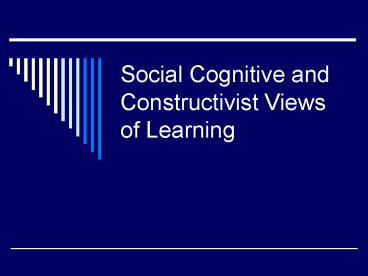Social Cognitive and Constructivist Views of Learning - PowerPoint PPT Presentation
1 / 11
Title:
Social Cognitive and Constructivist Views of Learning
Description:
Social Cognitive and Constructivist Views of Learning. Parents, Peers, and ... Support multiple perspectives and use multiple representations of content ... – PowerPoint PPT presentation
Number of Views:413
Avg rating:3.0/5.0
Title: Social Cognitive and Constructivist Views of Learning
1
Social Cognitive and Constructivist Views of
Learning
2
Parents, Peers, and Teachers as Social Influences
on Students
- Consider the following questions
- Jerome Bruner once said that learning in most
settings is a communal activity. Do you agree or
disagree? - How can peers be a negative influence on
learning? - What role does parents involvement play in
students choosing of social groups? - Parents who are authoritative
- Parents who are uninvolved
- Parents who are indulgent
- What does research tell us about cultural/ethnic
differences with respect to who kids identify as
those peers they most admire? - What influence can teachers have on students
learning? - What is enactive learning?
- What is vicarious learning?
- According to some research, For a large number
of adolescents, peers not parents are the
chief determinants of how intensely they are
invested in school and how much effort they
devote to education. What do you think about
this quotation?
3
Learning by Observing Others
- What is observational learning?
- What are the elements of observational learning?
- Attention (the facilitator/presenter must help
students attend to critical information by giving
clear presentations and highlighting important
information) - Retention
- Production
- Motivation (if learners anticipate being
reinforced for imitating the actions of the
model, they may be more motivated) - Reinforcement (direct reinforcement, vicarious
reinforcement, self-reinforcement) - Several factors influence observational learning
- Developmental level (as children grow older, they
can focus for longer and self motivate) - Status of the model (if students perceive that
the person modeling the activity whether it is
the teacher or an outside source like a guest
speaker or a person presenting information on
video is competent, prestigious, enthusiastic,
etc., they are more likely to observe the model
(hence, the reason that advertising agencies
often use entertainers for advertisements) - Vicarious consequences
- Outcome expectations (for observational learning
to take place, learners need to value the
outcome) - Self-efficacy (students need to believe that they
are capable of doing the activity of solving
the problem, etc.)
4
Observational Learning in Teaching
- Five outcomes of observational learning
- Directing Attention
- Fine-tuning already-learned behaviors by
observing others, students might better
understand which of their already learned
behaviors to use - Strengthening or weakening inhibitions
(ripple-effect) Teachers can reward or punish
behaviors, and especially if the person being
punished or rewarded is a class leader, the
behavior may be strengthened or weakened in the
others (i.e., the ripple effect is the
contagious spreading of behaviors through
imitation - Teaching new behaviors (modeling) Teachers can
model, but models who are the same age as the
students may be particularly effective, as may
well-known models (athletes, entertainers, etc. - Arousing emotion even if the person hasnt
experienced the thing, seeing the model (or
learning vicariously) may arouse emotions such as
fear
5
Reciprocal Determinism
- In social cognitive theory, internal and external
factors are important (and can all affect each
other) - Personal factors beliefs, expectations,
attitudes, knowledge - Physical and social environment resources,
consequences of actions, choices, other people,
physical settings - Behavior individual actions, choices, verbal
statements - The interactions of these forces is referred to
as reciprocal determination
6
Social Cognitive and Constructivist Views of
Learning
- Constructivism and Situated Learning
7
Constructivist Views of Learning
- Constructivism includes the learners contribution
to meaning and learning (building understanding
and making sense of information) through - Individual activity
- Social activity
8
Psychological/Individual Constructivism
- Some constructivists are interested in how
INDIVIDUALS build knowledge - Piagets psychological constructivist
perspective, for example, focuses not on
correct representations but rather on meaning
as constructed by the individual - Constructivist theories emphasize individual
meaning making but not to ensure students find
the right answer - as does most of information
processing - but rather on the process (product
vs. process).
9
Vygotskys Social Constructivism
- Vygotsky believed that individual development is
shaped by - Social interaction
- Cultural tools
- Activity
- Learners appropriate the outcomes that are
produced when they work together - Learners acquire new strategies and knowledge of
the world and culture when they work together
10
How is Knowledge Constructed?
- The realities and truths of the external world
direct knowledge construction (information
processing) - Internal processes such as Piagets organization,
assimilation, and accommodation direct knowledge
construction (Piaget) - Both external (cognitive) and internal
(environment and social) factors direct knowledge
construction (Vygotsky Bandura)
11
Common Elements of Constructivism
- Embed learning in complex, realistic, and
relevant learning environments - Provide for social negotiation and shared
responsibility as a part of learning - Support multiple perspectives and use multiple
representations of content - Nurture self-awareness and an understanding that
knowledge is constructed - Encourage ownership in learning































